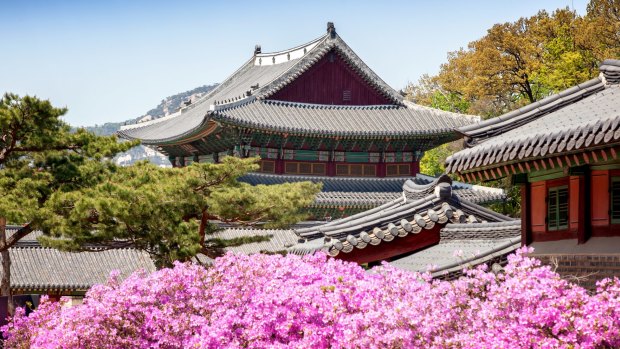
Changdeok royal palace in Seoul.Credit: Shutterstock
CHANGDEOK PALACE
Changdeok, on the northern edge of Seoul, was the favoured residence of the kings of the Joseon Dynasty, perhaps because of its pleasant informality. First built in 1405 and reconstructed in 1592, it is the best preserved and most interesting of several palaces in the Korean capital. Descendants of the royal family still live here, so you can only visit on guided tours, which last about 90 minutes. The highlight is the superb traditional garden full of ancient trees, fountains and pavilions, and framed by a backdrop of forested hills that are especially splendid in autumn. See eng.cdg.go.kr
GYEONGJU
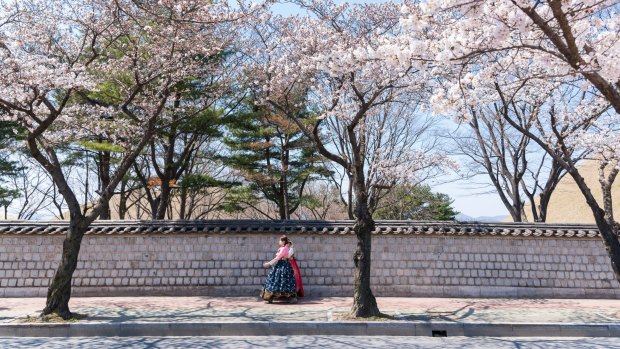
Spring in Gyeongju, South Korea. Credit: Shutterstock
Gyeongju was Korea's ancient capital during the great Silla Dynasty, which flourished between 57BC and 935AD. Remnants of these times are scattered around town and form one of the world's largest open-air museums. An ancient observatory, palace ruins, Buddhist statuary and royal tombs are the highlights. Head to the National Museum to admire the magnificent items unearthed from the royal burial mounds, including gold crowns, weaponry, Buddhist artworks and dazzling lapis luzuli. A giant and ancient bell hangs outside. It is Korea's best museum, and a decent audio-guide in English provides insight. See gyeongju.go.kr
BULGUKSA TEMPLE
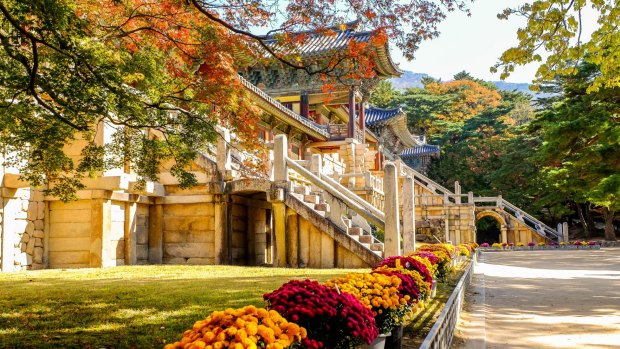
Bulguksa Temple in Gyeongju, South Korea. Credit: Shutterstock
Bulguksa Temple, in the hills 16 kilometres outside Gyeongju, is considered by Koreans to be both their top historic and scenic sight. It also houses seven national treasures, including two bridges and enchanting pagodas. The ornately wood-worked temple has been around since the sixth century, though most of what you see today is a relatively modern reconstruction. It sits on stone terraces amid iris ponds and gnarly pine trees. The temple's Buddha has a smile of serene benevolence, not surprising considering the glorious architecture of the colourful pagodas and the beauty of the surrounding hillsides. See bulguksa.or.kr
HWASEONG FORTRESS
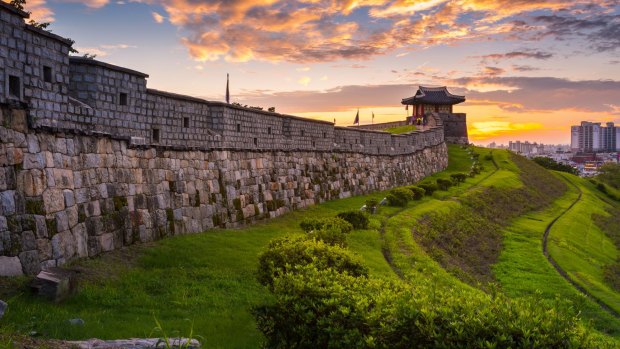
Hwaseong Fortress in Suwon, South Korea.Credit: Shutterstock
Just south of Seoul and easily reached by train, Suwon city was laid out by King Jeongjo in the 18th century and is crowned by a magnificent fortress, cutting-edge for its day, and an outstanding example of military architecture. The walls, punctuated by four massive gates, run for nearly six kilometres, about three-quarters of which can be followed on foot. Inside, there are more than 40 towers and brightly painted pavilions made of stone, brick and wood, all linked by scenic walks shaded by pine trees and erupting in azalea. Cherry trees flower in springtime. See visitkorea.or.kr
HAEINSA TEMPLE
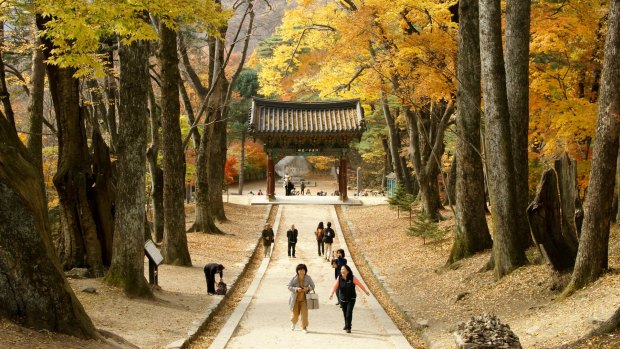
People enter Haeinsa Buddhist Temple in Daegu, South Korea. Credit: Shutterstock
The Temple of Reflection, surrounded by mountains deep inside Gayasan National Park in south-central Korea, is largely World Heritage listed for its almost perfectly preserved 80,000 wood-printing blocks whose 52 million characters comprise the world's oldest and largest Buddhist canon. It also has fine sculptures and paintings. This is still, however, an active monastery, and visitors are welcome to stay and join monks in their daily rituals. Drums wake you for morning service in the wee hours. Buddha statues glow by candlelight, paper lanterns glow and monks chant in a ceremony a thousand years old. See visitkorea.or.kr
JEJU ISLAND
For a change from culture, Jeju, off Korea's southern coast, is a favoured destination for Korean honeymooners and holidaymakers, thanks to its balmy semi-tropical climate, spectacular sea cliffs, waterfalls and black-sand beaches. It has World Heritage listings for hike-worthy extinct volcano Mount Hallasan, whose crater cups a startlingly blue mountain lake, and for the world's best lava tube system, whose large tunnel-like caves run for kilometres. You can visit part of the lava tube at Manjanggul Cave, which has multi-coloured lava stalactites, flowstone and columns, and also houses a huge colony of bats. See ijto.or.kr
Brian Johnston was a guest of the Korea National Tourism Organisation and has also visited Korea at his own expense.
Sign up for the Traveller Deals newsletter
Get exclusive travel deals delivered straight to your inbox. Sign up now.